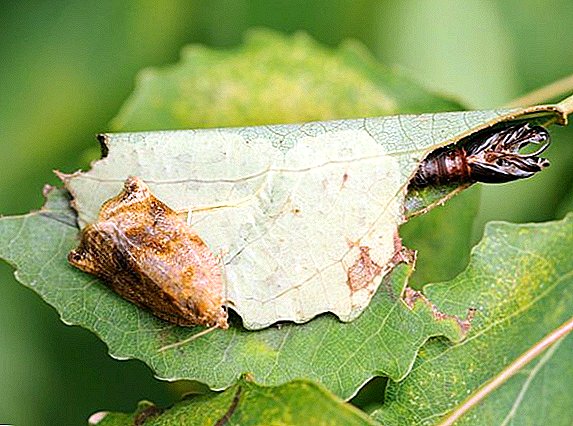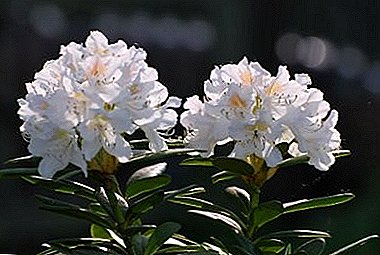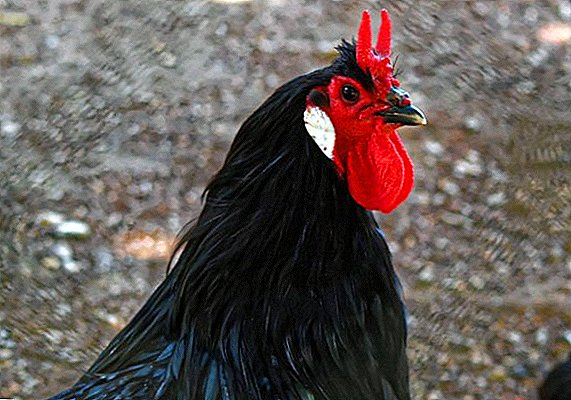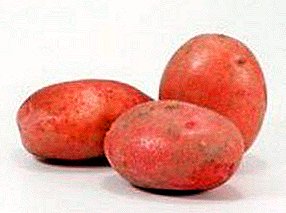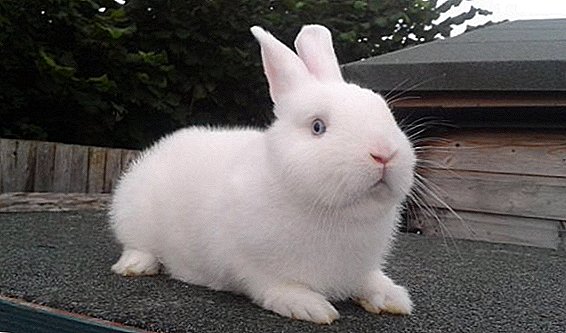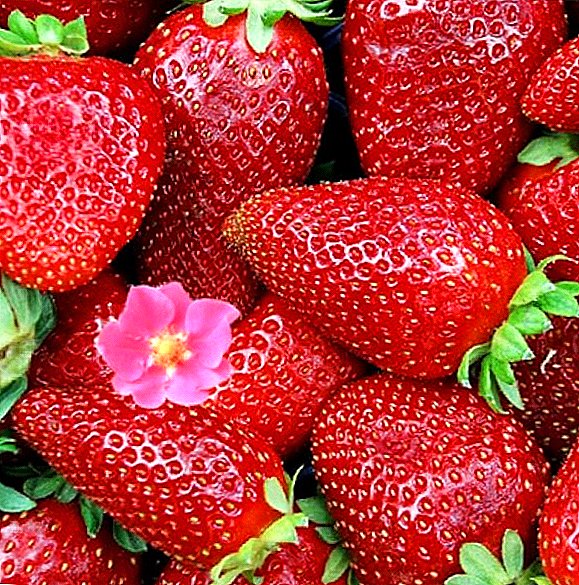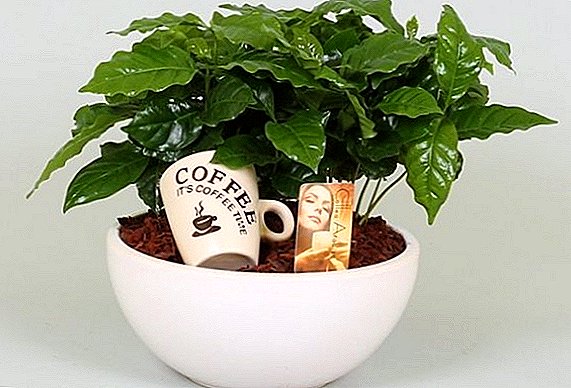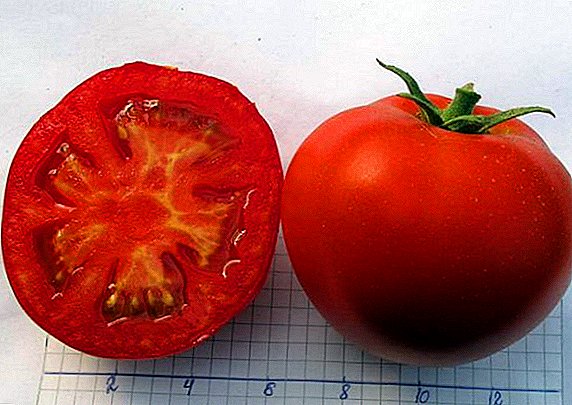 Many gardeners almost every year look for more and more new plant varieties, choosing the most interesting option. Considering each of them, it is very important to pay attention not only to the external, but also to the taste characteristics of future fruits, and information about the correctness of care will not be superfluous. In this article, we will answer all such questions regarding the Juggler tomato, so that you can decide whether this variety is worth your attention.
Many gardeners almost every year look for more and more new plant varieties, choosing the most interesting option. Considering each of them, it is very important to pay attention not only to the external, but also to the taste characteristics of future fruits, and information about the correctness of care will not be superfluous. In this article, we will answer all such questions regarding the Juggler tomato, so that you can decide whether this variety is worth your attention.
Variety description
Tomato "Juggler" refers to the early ripening hybrid varieties, which have a fairly high yield.
By early ripe hybrid varieties also include such as "Irina", "Samara", "Bokele", "Tolstoy", "Katya".
Compact and determinant bushes are characterized by a relatively small number of leaves and can grow up to 60 cm in height in open soil and up to a meter in greenhouse conditions. 
Sheet plates - small, dark green and do not differ in any special form. Lightly crimped tops - the same dark green color, requires the presence of support. Inflorescence - simple.
The main advantages of the "juggler" are:
- good fruit taste;
- fast ripening;
- relatively high yield (if all agrotechnical requirements are met, up to 9 kg of tasty tomatoes can be collected from one square);
- high resistance to adverse external factors;
- good immunity to various ailments.
In addition, some of the features of these tomatoes are also completely worth it: for example, even and dense fruits of flat-rounded shape can easily ripen already plucked, gradually changing their green color to red. 
But this is not the main thing, because even the inhabitants of Siberia and the Far East can grow the described variety, sowing seeds either for seedlings, or immediately for a flower bed.
As for the shortcomings, no serious problems were found during the cultivation of the "Juggler".
Did you know? Latin tomato is called "Solanum lycopersicum", which literally translates as "wolf apricots without the sun."
Fruit characteristics and yield
The fruits of the "Juggler" are represented by medium-sized tomatoes and a rather mediocre mass, which usually does not exceed 90-150 g. During ripening, the color of a flat-rounded fruit with a barely noticeable ribbing at the stem changes from light green to rich red.
This is a very juicy tomato with moderately dense pulp and a large number of seed chambers. It contains about 4% solids and 2.3% sugars. Fully ripened fruits are characterized by a bright, sweetish taste and do not contain much water. 
They are perfect for both fresh consumption and for processing into pastes, mashed juices, or for whole-fruit preservation.
Learn how you can prepare tomatoes for the winter, how to cook adjika, how to pickle, how to cook ketchup, how to make tomatoes under a capron lid, how to make dried tomatoes, how to cook tomato juice, tomatoes in their own juice, how to freeze.
Juggler tomatoes ripen in rather large clusters, 8-10 pieces in each, and up to 30 fruits can be in one bush.
The yield of a variety can be called high, since it averages 9 kg of selected tomatoes per square meter of land (with regular dressings and sufficient watering, this value can increase to 12 kg or even more). 
When planting seedlings early, wait for the first harvest closer to mid-end of July.
Selection of seedlings
If you do not want to engage in independent cultivation of seedlings, then you have to go to the market and purchase already grown shrubs "Juggler". 
Of course, it is not worth taking the first plant, but it is possible that it will have all the important qualities.
Let's find out what the criteria for the selection of tomatoes exist, and what you need to know about this process in the case of the described variety.
Did you know? The name tomato comes from the Italian "pomo d'oro", which means "golden apple". The name "tomato" is rooted in the homeland of this plant, in South America, where local tribes called the fruit "tomatl".
So, first of all, pay attention to the following features:
- The appearance of the green mass. If the chosen seedlings have a very thick trunk and huge leafy plates of bright green color, then it is better to pass by. Despite the attractive appearance, good ovaries from such a plant can not be obtained, but useless tops will grow throughout the garden. Most likely, such seedlings are simply overfed with nitrogen.
- Pallor of plants. In comparison with the previous version, long thin stems and yellowed lower leaves do not look so attractive, so it is unlikely that anyone would want to buy such seedlings. This is completely the right decision, because these plants are unlikely to take root in your area.
- Number of sheets. If you like everything in the appearance of the chosen seedling, then it will be useful to count the leaves. A healthy and strong instance will have at least seven. The bottom leaf plates must be intact, without yellowing or browning. However, these requirements apply to the rest of the "body" of the plant.
- The thickness of the trunk. Ideal - just like a pencil or a little thicker.
- Location of seedlings for sale. If the seller gets you seedlings from the box, literally hammered by them, then it is likely that the root system is already damaged. Of course, over time the roots will grow, but it will take time and you will lose at least a week. Also pay attention to the state of the root system: it should not be dry or with obvious signs of putrid lesions.
- Seller. Do not buy seedlings from the first person encountered, even if he will assure you of the high quality of their goods. If possible, it is better to purchase seedlings in proven places where you can guarantee its good further development.

Important! If you buy several plants from different people, then it is very important to ensure their health. Putrid lesions or viral ailments (for example, mosaic) can easily destroy all your supplies.
Soil and fertilizer
As with the cultivation of many other varieties of tomatoes, in the case of the "Juggler" it is worth avoiding clay, heavy loamy and acidic soils (with a pH below 5).
It is also worth ensuring that the selected substrate does not have a large amount of fresh manure, since this will only lead to an increased growth of green mass and insufficient development of the ovaries and future fruits.
Whatever way you planted tomatoes (right in the greenhouse or first on the seedlings), be sure to follow from where the substrate was taken. If last year potatoes, peppers, peas, eggplants, or other varieties of tomatoes were grown on it, then it is likely that the land has also retained pathogens.
Sort "Juggler" has good resistance to most typical "tomato" ailments, but it's better not to risk it once again. 
Before direct planting of seeds in the soil, it is useful to process it with high and low temperatures, leaving it to freeze for several days, and then calcined in an oven or steamed in a water bath. These actions will help to decontaminate the substrate as much as possible and protect your seedlings from infection.
Growing conditions
Planting seeds in the prepared soil is only half the battle, and the second half is to organize and maintain all the necessary conditions for successful growth and development of seedlings.
For the Juggler variety, the ideal temperature will be values within + 20 ... +25 ° С, with a permissible nightly drop to +16 ° С. The room with planted tomatoes must be regularly ventilated, but protecting plantings from drafts.
Important! To obtain a bountiful harvest of tasty tomatoes, sowing the "Juggler" on seedlings should be carried out not earlier than mid-April, and its planting in open soil is best performed after June 10.

Growing from seed to seedlings at home
For those who live in a temperate or cold climate, planting tomatoes on seedlings will be an excellent chance to speed up the process of harvesting, because while young seedlings grow and strengthen at home, the soil on the site will have time to warm up well.
Consider the features of all actions for growing seedlings varieties "Juggler."
Seed preparation
You can prepare the seeds for planting in several ways: just wrapping a day in a damp soft cloth or soaking in a special growth stimulator. Which option to choose - each gardener decides on his own, but if you believe the reviews, then after stimulants, sprouts and the truth are shown faster.
Content and location
For the cultivation of tomato seeds, "Juggler" is perfect light and nutritious substrate based on humus. 
You can cook it yourself, or you can buy a ready-made version in flower shops.
In any case, before planting the seeds, it is desirable to saturate the soil with a solution of copper sulphate or potassium permanganate. When preparing the soil yourself, you will need humus, peat, turfy ground and rotted sawdust, taken in equal parts.
In addition, a glass of wood ash, as well as 3 tablespoons of superphosphate and one potassium sulfate should be added to the bucket of the finished mixture.
As for the location of the boxes with seedlings, then you should pay attention to the most sunny rooms in your house, with an air temperature not lower than +20 ° C. Young plants accustom to lower temperatures only after several weeks.
Did you know? Today, the largest tomato grown in recent years is the fruit weighing 3.8 kg, which in 2014 was received by Dan McCoy from Minnesota.
Seed planting process
Seeds for seedlings can be sown in March, having prepared in advance both the planting material and the soil. 
This process looks like this:
- Soak the seeds in a special growth stimulator for a day (this treatment will further accelerate the process of the emergence of young plants).
- Pour the prepared soil into containers and slightly moisten with a spray bottle.
- Remove the seeds, dry them a little and deepen to the substrate by 1 cm, leaving 2 cm of free space between neighboring plants.
- Top with planting fertile substrate or peat, but only a layer thickness of not more than 1 cm.
- Cover the boxes with film or glass and place in a warm room.
As soon as the first shoots appear and get stronger, the film cover can be removed, and the boxes themselves put on the windowsill. If you have small containers, then in each of them you need to plant 2-3 seeds, then to leave only the strongest sprout. 
Seedling care
Tomato seedling "Juggler" does not differ too high requirements in terms of care. Having planted the seeds, they are immediately sprinkled with warm distilled water (for convenience, a spray bottle can be used) and left to grow in a warm room.
Re-hydration is performed as soon as the topsoil begins to dry out. To speed up the process of seed development, you can feed them with a specially created solution prepared from one liter of pure water, 1 g of ammonium nitrate and 2 g of superphosphate.
Spray the nutrient mixture on the surface of the soil will help the same atomizer.
As for the lighting, then for the "Juggler" a bright, diffused light coming to young plants within 12-14 hours a day will be a good solution. If there is not enough natural light, then you will have to install additional lamps. 
Growing seedlings, after the emergence of two true leaves, do not forget to dive it into separate containers, and three weeks before planting in open ground you can begin hardening: every day pots with young plants are brought to the balcony for several hours, while reducing the number of waterings and providing sufficient seedlings fresh air intake.
Transplanting seedlings to ground
It is possible to transplant young plants to their permanent place of growth not earlier than in 50-55 days after the first shoots., adhering to the scheme 4 seedlings per square meter of territory.
The transplant process should look like this:
- Three days before the proposed disembarkation, cut off the three lower leaves from the stems, leaving only small penychki (this is necessary to improve ventilation, protect against ailments and strengthen the fruitful brush), and lastly pour the seedlings abundantly.
- The day before the seedlings move, dig holes, the size of which should be slightly larger than the size of the seed tank.
- Pour into them a pouch of superphosphate and cover it with water, and when it is fully absorbed, repeat the action three more times.
- Remove the seedlings from the seedling containers by simply passing them over and place each in a separate well.
- Deepen the seedling, fill the hole with the remaining soil and water the plantings well.

The next watering will be done a week after planting, and until that time it is best to leave the tomatoes alone.
Agricultural technology of growing tomato seeds in the open ground
Growing tomatoes "juggler" in the open soil is slightly different from the same process in room conditions and above all, this difference lies in the instability of the temperature regime.
Outdoor conditions
Tomatoes varieties "Juggler" can be grown both in open areas and in greenhouse conditions, however, in the latter case, they will bring a higher yield.
These tomatoes are notable for their increased resistance to sudden temperature changes and changes in weather conditions, but still prefer areas that are well lit by the sun's rays. 
In addition, in the selected area should be fertile and nutritious soil. It is desirable to prepare the substrate for planting in the fall, digging the beds and bringing rotted manure or compost fertilizer to the ground.
If we are talking about a greenhouse, then it is better to completely replace 12 cm of the top soil layer, fertilizing the new substrate with potassium salt and superphosphate at the rate of 40 g per 1 square meter.
Important! In both conditions, onions, garlic, cucumbers, root vegetables, legumes and siderats will be good predecessors for the "Juggler".
The process of planting seeds in the ground
For summer residents living in temperate climates with a rather hot summer, the sowing of tomato seeds of the described variety can be done as early as May, when the soil warms up well and the risk of sudden frosts is minimized. 
The implementation of all actions is almost similar to the work carried out when sowing seeds on seedlings, and the difference is only in the nuances.
The landing sequence is as follows:
- Preparation of seed material by soaking in a growth stimulator (you can - only for a day, but you can - until small sprouts appear).
- The organization of shallow grooves for seeds (it will be enough three centimeters deep).
- Sowing of seeds with an interval of 5 cm (later on, weak and redundant sprouts will be removed so that there will be at least 40 cm between the grown and grown strong plants).
- Sealing holes with seeds and their abundant watering.
- Shelter beds film, which is especially important for regions with a cool spring.
To prevent mold, plantings should be regularly aired, especially if we are talking about areas with slightly acidic and acidic reactions of the soil. 
Important! Always plant the seeds with a reserve, and if you plan to leave only one sprout, then put in the hole at least 3-4 seeds.
Watering
The frequency of irrigation and the amount of liquid applied directly depend on the developmental stage of the tomatoes and the weather conditions. Tomatoes of the described variety are capable of tolerating a short-term drought, but it is better to water them daily: in the morning and in the evening, using only water defended in the sun for irrigation.
The scheme of making a liquid under the bushes "Juggler" looks like this:
- more water will be needed immediately after planting seeds or seedlings;
- the next time watering is carried out after 7-10 days after planting;
- in the period just before flowering, tomatoes are watered every four days, using 3 liters of water per bush;
- during the formation of inflorescences and ovaries, 4 l of water are brought under the bush every week.
- As soon as fruits appear on the plants, the frequency of watering is reduced to twice a week using two liters of liquid.
Never forget that excess moisture only contributes to the appearance of fungal ailments and cracking of fruits, and its lack can lead to shedding of the ovaries and yellowing of the leaves.  Try to stick to moderation, taking into account the condition of the topsoil.
Try to stick to moderation, taking into account the condition of the topsoil.
Soil loosening and weeding
Loosening the soil and removing weeds is a prerequisite for the full development of tomatoes. Basically, these two procedures are combined with each other and performed after the next watering (water must be absorbed) in order to break the crust on the soil surface.
If we are talking about young plants that were planted with seeds right on the garden bed, then, along with the removal of weeds, we can also pull out extra weak sprouts from the ground.The main thing when loosening is not to damage the roots of healthy and full-fledged tomatoes.
Masking
When growing tomatoes "Juggler" gardener need to know about the need for partial pasynkovaniya plants.
Learn how to properly pinch tomatoes in the open field and in the greenhouse.
The bush is formed only in 3 stalks and all stepchildren, which can thicken the planting, are sure to be removed. 
This procedure should be carried out as necessary, so that the extra shoots do not steal nutrients from the main shoots.
Important! On the package with seeds, you can find information that this hybrid variety does not stepchildren, but, as practice shows, for a bountiful harvest you still have to perform this procedure.
Garter
Despite the fact that the "Juggler" refers to undersized tomatoes, it is still recommended to tie up to a support. Alternatively, you can install a trellis, consisting of several supporting bars and a wire stretched between them.
As an alternative, you can simply drive the pegs near each bush and attach the stem to them using soft fabric tapes. 
Top dressing
For tomato varieties "Juggler" provides for the use of complex mineral fertilizers and organic matter.
The complex mineral fertilizers include such as "Sudarushka", "Master", "Kemira", "AgroMaster", "Plantafol".
Between dressings should take at least 15-20 days, that is, in one season, about 5 dressings are conducted.
As for the specific mode of fertilizer application, then if you did not feed the seedlings at home, you will have to perform the first procedure two weeks after planting the tomatoes on the bed (we do not take into account the fertilization of the soil at the planting itself).
This time, the role of the nutrient composition is perfectly suited solution of mullein, in a ratio of 1:10. One bush requires 1 l of such fertilizer.
The second time, that is, after 15-20 days, you can fertilize the soil already using superphosphate and potassium salt dissolved in 5 liters of water (you need to take 15 g of each substance).

Phosphorus will stimulate metabolic processes in the body of the plant and strengthen the root system, and potassium will significantly improve the taste of tomatoes.
The prepared solution is made under the root of tomatoes.
The following dressing can be done with the use of wood ash, replacing the already familiar mineral compositions. The ashes are simply buried in the soil when loosening or sprinkling the soil with a solution of 200 g of ash, dissolved in a bucket of water and infused for 24 hours. Ready infusion bushes watered at the root.
You can alternate these supplements, and you can choose something of your own, as long as tomatoes receive all the necessary nutrients in each separate period of their development.
Pests, diseases and prevention
Given the hybridity of the described varieties, it is not surprising that many of the familiar diseases of the “Juggler” are not terrible. However, this does not mean that you should not engage in prevention. 
For example, Ordan and Fitosporin preparations will help prevent the development of late blight, the last spraying of which should be performed 20 days before the intended harvest.
In addition, you can always treat the area with copper sulphate and potassium permanganate before planting, and in the process of growing tomatoes perform regular loosening and weeding, which will ensure sufficient filtration and prevent the development of root rot.
As for cultivation in open ground, it is not necessary to exclude the possibility of damage to plants by various insects. In the fight against them will help industrial insecticides, which plantings are treated several times, keeping to an interval of 2-3 days.
If the tomatoes attacked the slugs, then scare them away with ammonia. 
Important! Always clearly adhere to the dosage indicated on the package with the selected fungicide or insecticide, otherwise there is every chance not only to burn the leaves, but also to remain without a crop.
Harvesting and storage
If you used a seedling method for planting tomatoes, the first crop can be harvested in mid-July, while sowing seeds immediately in the soil this time will be as close as possible to the end of summer or even early September.
The process of harvesting itself differs little from the removal of other varieties of tomato, and all you need is to simply lay out the plucked and whole fruits in boxes, immediately discarding rotting or cracked specimens.
If you had to pick not quite ripe tomatoes - no problem, they will be able to walk at home. As for the quality of the bed, in a dry basement, at a temperature of +6 ° C, tomatoes can be safely stored all autumn, until the beginning of winter. 
Possible problems and recommendations
Even if your plants are not affected by diseases or pests, this does not mean that there will be no problems. Tomatoes are very sensitive to almost any changes, so if your “Jugglers” suddenly begin to turn yellow and fall leaves or fruits fall from the bushes, then you should reconsider the mode of irrigation and fertilizing.
For example, small tomatoes and lush green tops usually indicate an excess of nitrogen, yellowing of the leaves in seedlings indicates a lack of moisture in the soil, and the fall of the ovaries or their poor formation can be associated with a sharp decrease in night temperatures.
Otherwise, there should be no significant problems with this hybrid, and following the rules of agrotechnology, you can easily grow tasty and juicy tomato fruits in your area.


